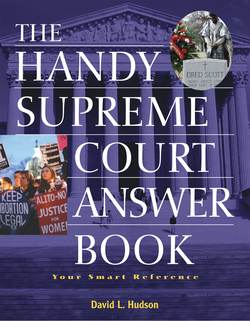Читать книгу The Handy Supreme Court Answer Book - David L Hudson - Страница 41
How many judges on the Court of Appeals hear individual cases?
ОглавлениеMost cases that reach the federal appeals courts are heard by panels of three judges. Sometimes the panel consists of three federal appeals court judges and sometimes it is composed of two federal appeals court judges and a district court judge within that circuit.
The Current Federal Appeals Courts
There is one national federal appeals court, called the Federal Circuit, that hears specialized cases, such as patent and civil service personnel cases, that arise throughout the country.
There are also twelve regional courts of appeals based in various parts of the country. Each one hears cases coming through the federal court system from specific geographic regions of the country.
D.C. Circuit (located in the District of Columbia): covers the District of Columbia
First Circuit (Boston): Maine, Massachusetts, Rhode Island, and Puerto Rico Second Circuit (New York City): Connecticut, New York, and Vermont Third Circuit (Philadelphia): Delaware, New Jersey, Pennsylvania, and the Virgin Islands Fourth Circuit (Richmond): Maryland, North Carolina, South Carolina, Virginia, and West Virginia
Fifth Circuit (New Orleans): Louisiana, Mississippi, and Texas
Sixth Circuit (Cincinnati): Kentucky, Michigan, Ohio, and Tennessee
Seventh Circuit (Chicago): Illinois, Indiana, and Wisconsin
Eighth Circuit (St. Louis): Arkansas, Iowa, Minnesota, Missouri, Nebraska, North Dakota, and South Dakota
Ninth Circuit (San Francisco): Alaska, Arizona, California, Hawaii, Idaho, Montana, Nevada, Oregon, Washington, Guam, and the Northern Mariana Islands
Tenth Circuit (Denver): Colorado, Kansas, New Mexico, Oklahoma, Utah, and Wyoming
Eleventh Circuit (Atlanta): Alabama, Florida, and Georgia
When a party loses a case before a three-judge panel, the losing party can then appeal for full-panel, or en banc, review. En banc review means that the full panel of non-retired members of the federal appeals court will sit and hear the case. This number generally ranges from eleven to fifteen. Federal Rules of Appellate Procedure, Rule 35, provides: “An en banc hearing or rehearing is not favored and ordinarily will not be granted unless: (1) en banc consideration is necessary to secure or maintain uniformity of the court’s decisions; or (2) the proceeding involves a question of extreme importance.” There is no exact science as to when a court might grant en banc review. But Rule 35 offers two possibilities—when the panel decision conflicts with an earlier panel decision or when the case is extremely important.
U.S. Supreme Court’s Original Jurisdiction
“The Supreme Court shall have original and exclusive jurisdiction of all controversies between two or more States. (b) The Supreme Court shall have original but not exclusive jurisdiction of: (1) All actions or proceedings to which ambassadors, other public ministers, consuls, or vice consuls of foreign states are parties; (2) All controversies between the United States and a State; (3) All actions or proceedings by a State against the citizens of another State or against aliens.”
